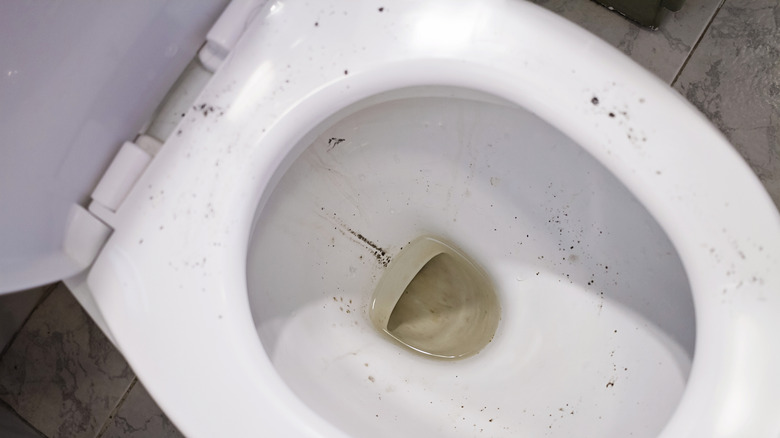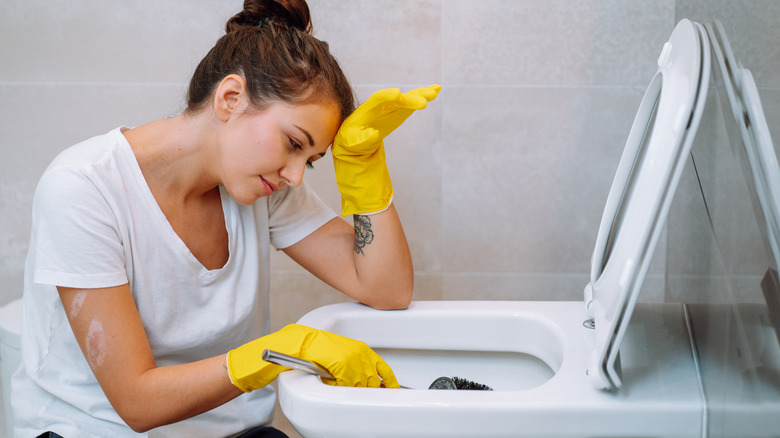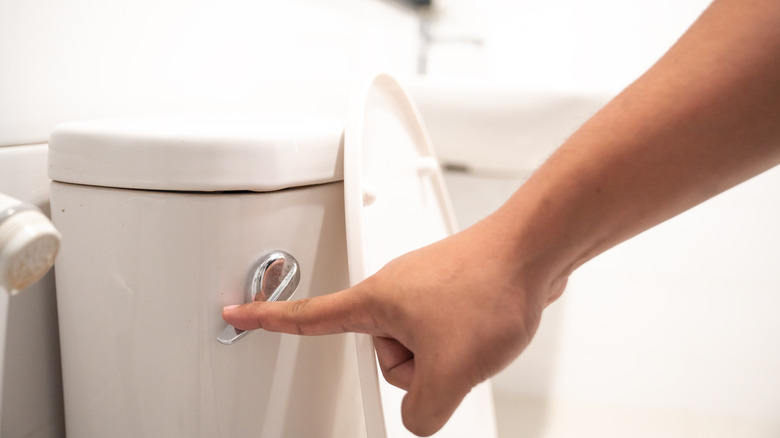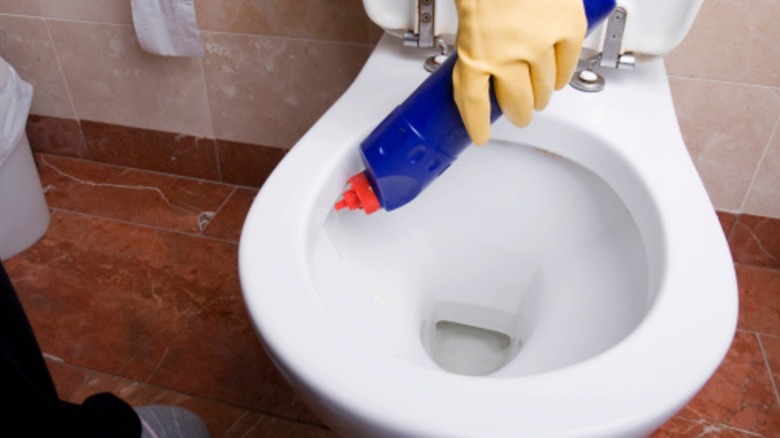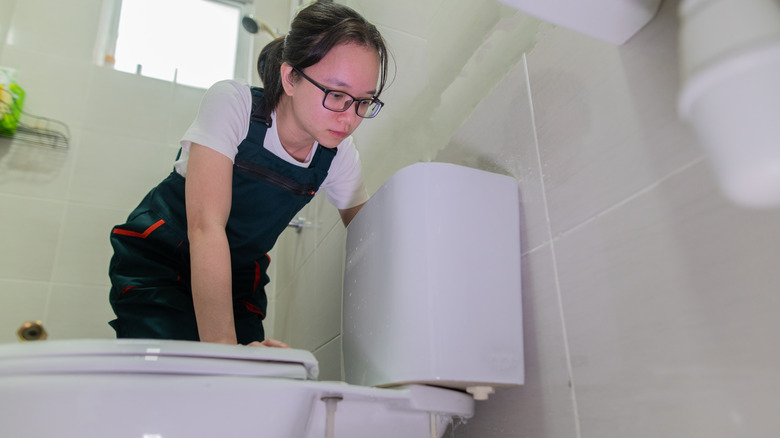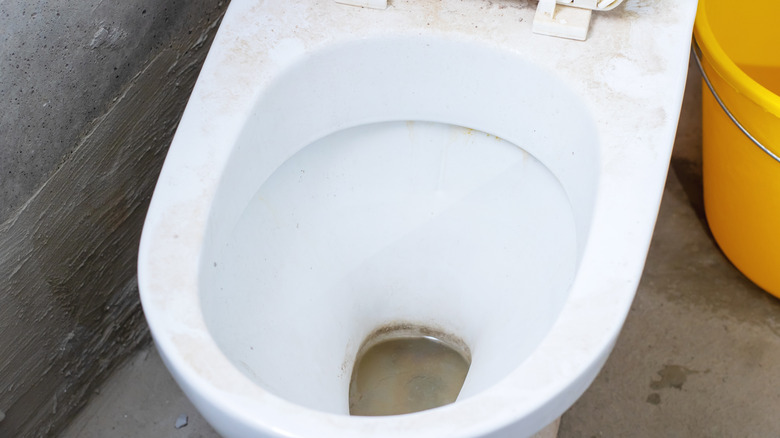Reasons The Mold In Your Toilet Bowl Just Won't Go Away
We may receive a commission on purchases made from links.
Finding mold anywhere in your bathroom is never a pleasant experience. You question how long it's been there and whether it could be making you or others in the house sick. It's natural to want to immediately get rid of it to ensure that your bathroom is safe. There are several bathroom items that can become a breeding ground for mold that we often focus on — such as the shower curtain, toothbrush holder, and bath mats. However, these aren't the only areas where the microorganism may grow. Sometimes, mold grows in the toilet. And, getting it to go away (and stay away) can be more challenging than you might think.
Unfortunately, there are several reasons why mold may keep appearing in your toilet despite your best efforts to get rid of it. Before we take a closer look at each of these potential causes, though, let's take a quick step back to make sure you're correctly identifying what those black stains actually are. Depending on the location of the stains, you may not actually be dealing with mold. Oxygen must be present in order for the fungus to grow. So, if the stains are on the upper part of the bowl that is above the water, then they likely are mold. However, if the toilet water is black or the stains are below the waterline, then you may be dealing with manganese deposits instead. Once you've determined that mold is, in fact, your problem, follow along below to find out the reasons your bathroom may be mold central.
You are waiting too long to clean the toilet
One of the primary reasons that mold may be growing in your toilet comes down to how frequently you are (or are not) cleaning it. If you stretch out the time between cleanings too much, then you may inadvertently be creating the ideal conditions for the spores to grow. Mold requires a few things in order to proliferate. These include moisture, oxygen, and a source of food. So, let's break down how each of these needs can be met in a toilet, especially one that hasn't been cleaned recently. Moisture is the most obvious one. Not only is there water in the bowl, but humidity levels also tend to be higher in a bathroom, adding to the overall moisture levels. Oxygen is also readily available in the toilet, particularly the areas above the waterline. So, what about a food source? Here is where cleaning (or not cleaning) really comes into play. Any organic matter, including fecal waste, can be a food source for mold. When you go too long without cleaning your toilet, more organic waste matter will be present in the bowl (even if you don't see it), providing the food to help the mold grow.
Fortunately, this is a simple problem to solve. If you increase how frequently you are cleaning the toilet, you'll be removing that waste residue more regularly, and depriving the mold spores of what they need in order to grow. Aim to clean the toilet at least once per week. If you find that you still have a problem with cleaning it this frequently, consider addressing some of the other potential causes of mold that are shared below.
The toilet isn't being used and flushed frequently enough
If the toilet that has a mold problem is one in a guest bathroom or another location that is rarely used, that could also be the cause of the issue. There are always mold spores in the air. They land on surfaces, such as a toilet. If given the chance, they can begin growing. An infrequently flushed toilet is going to provide them with that opportunity to grow. The water isn't moving around or rinsing the spores off the edges of the bowl. Instead, they're just sitting there, getting the oxygen they require. If they can also fill their need for a food source from any organic matter, then it won't be long until the spores start growing and covering the inside of the bowl with unsightly and dangerous mold.
To prevent this from being an issue, be sure to periodically flush all the toilets in the home — ideally at least once per week. With the water circulating more often and rinsing more of the spores away, they'll be less likely to start growing. Water supplies are often chlorinated, so you'll also be adding some chlorine to the bowl, which will also help prevent the spores from growing.
The bathroom is overly humid
The humidity level in a bathroom is generally higher than that of many other rooms in a home. Those hot and steamy showers, poor ventilation, and other factors can all contribute to the increased moisture in the air. While higher humidity levels are to be expected, if they are too high, it could be the reason why you're having trouble keeping mold out of your toilet. If you remember from above, the microorganism thrives in moist environments. There's already moisture around the toilet from the water in the bowl, so if the air is also overly humid, you're just asking for mold to grow here (and on other surfaces, as well). Specifically, mold is more likely to grow in bathrooms where the relative humidity level is above 55%.
Taking steps to lower the humidity level in your bathroom can go a long way towards keeping mold from coming back in the toilet. Consider slightly decreasing the water temperature when bathing and cutting back on how long you stay in the shower. Doing so will create less steam (which is water vapor that will form condensation and increase humidity levels). Also, don't forget the bathroom etiquette rule that helps prevent mold and mildew: always turn on the extractor fan before you start your shower. It is designed to pull moist air from the room, effectively lowering the humidity level. Wiping condensation from the windows, mirrors, and other surfaces can also help keep humidity levels as low as possible. If making these changes doesn't sufficiently lower the moisture content in the air, then you may want to consider using a dehumidifier to extract more water.
The air in the bathroom is stagnant
The air in the bathroom is already moist, if it is also stagnant, or not moving around, it's going to further exacerbate a mold problem. When the air is stagnant, excess moisture isn't going to be removed from the space. This will make it more likely that mold will grow. Additionally, the spores in the air are more likely to settle on the toilet and other surfaces in the bathroom if the air isn't moving, giving them more of an opportunity to grow.
There are a few things you can do to improve the flow of air in a bathroom. One of the most important is to make sure that you have an extractor fan installed and that you are running it regularly, especially when showering. The best way to vent a bathroom to keep it mold-free also involves making sure that you have the right fan for the space. Consider the CFM rating compared to the square footage of the space. You could also consider installing an automatic timer, such as the TopGreener Circulator Switch, that will turn the fan at set intervals to enhance regular airflow. If your bathroom has a window, opening it when showering or throughout the day can also make a difference. Additionally, when no one is using the bathroom, leave the door to the hallway or bedroom open. This will allow air to flow more freely between the spaces to keep it from being stagnant.
You are choosing the wrong cleaners
If you feel like you're scrubbing away the mold only to have it reappear within a few days, then you might not be using the right cleaning products. Mold is difficult to eradicate, and if you don't fully kill the microorganism, it is going to come back quickly. Choosing one of the best toilet cleaners to keep your bowl sparkling clean and mold-free (like the Lysol Power Toilet Bowl Cleaner Gel) is essential. The cleaner you choose should be formulated with bleach, which has been shown to be effective at killing the fungus. If you continue having a mold issue, you could also consider adding about ¼ cup of bleach into the toilet tank and waiting about 15-20 minutes before flushing a few times. This will help distribute the bleach through more of the components. Clip-in disinfectants, such as the Clorox Ultra Clean Toilet Tablets Bleach & Blue, can provide a more regular distribution of bleach, though they shouldn't replace regular cleaning.
If there is already mold growing in your toilet, you will need to take some extra precautions before cleaning it. Exposure can cause respiratory issues and other problems, so always wear long rubber gloves, non-vented goggles, and a respirator mask, such as the 3M Aura Particulate Respirator. When working, be sure to open a window or switch on the extractor fan to ensure adequate ventilation. You can use vinegar to kill the mold in the toilet — but be careful to avoid mixing it with any bleach, which is extremely dangerous. Pour about 1 cup of vinegar into the tank and 1 cup into the bowl. Sprinkle baking soda over the vinegar in the toilet bowl, and try to coat the underside of the rim with the powder as well. After an hour, thoroughly scrub everywhere, wait about 20 minutes, and then flush the toilet.
There is a leak somewhere
Hidden leaks in a bathroom can cause serious problems. While your mind might immediately think about all of the water damage that a leak could cause, that's not the only issue that could arise. If water is running in the toilet bowl constantly, it is increasing the moisture levels in the bowl. Even if water is leaking elsewhere in the bathroom, there is going to be more moisture in the air of the bathroom overall. Moisture in the air, along with potential condensation on the various plumbing components of the toilet, can create an ideal breeding environment for mold.
It doesn't have to be a huge leak, either. Just because you don't see water gushing out of the toilet, it doesn't mean that there's not a small leak lurking somewhere that is facilitating the growth of mold. Take time to inspect the area. Get to the bottom of what's causing the toilet to leak at the base or another location. If you can't determine the cause — or even the location of the leak — yourself, contact a plumber. You want to quickly resolve the water issue to keep moisture levels down in the bathroom.
Mold spores are lurking in your water supply
It's rare, but possible, that mold spores are lurking in your water supply. This would be most likely to occur if you rely on well water or a reservoir that has also been contaminated. If this source is contaminated, then the water that is being run through your pipes will also have the spores present. Occasionally, mold may also grow in the pipes of a home if there is a hidden leak somewhere. The moisture along the pipe can facilitate its growth. Then spores of the fungus will come out of the faucets and flow into the toilet.
Fortunately, this scenario is unlikely. Water regularly flowing through a home plumbing system is typically sufficient to avoid the conditions that are necessary for the microorganism to grow. Moreover, mold must have an organic food source in order to grow. So, unless there is a hole along the supply line or in your plumbing system, it would be impossible for organic matter to enter the pipes and allow the microorganism to grow. However, if you've eliminated the other possible causes for mold growth outlined above, it is probably worth a call to a plumber to have your system inspected to rule out this possibility.
